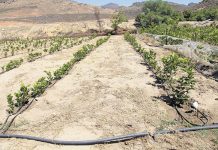Agronomist Jim Klauzer gets the best view of the onion industry below ground level.
“We are really big on moisture monitoring,” said Klauzer, with Clearwater Supply in Ontario, Ore. He has been in the job for 18 years, often helping onion and other crop growers tap advances in drip irrigation.
Paying attention to onion plants and the water beneath them can help growers optimize quality and yield, he said. They don’t have to use drip irrigation to do this, though he has seen the mode become much more common in onion fields during his tenure.
One of Klauzer’s favorite tools is a sensor made of a hard-plastic tube about a fourth as long as a broom handle with a porous dome on one end and wire-connected readers on the other. It reads in centibars, which express water content as a tension force holding water in the soil to provide a sense of how hard the plant works to extract the moisture. If the sensor is in a bucket of water it reads zero. If it’s in the hot sun or an oven it reads 200.
He also likes graphs showing peaks and valleys representing water volume over time. Ideally, the graphs show the onion grower applied the right amount of irrigation water at the right time and made adjustments a key points in the growing season.
Onions grow best between 15 and 30 centibars, Klauzer said, citing research from Oregon State University’s Malheur Experiment Station near Ontario. In that range, the onions aren’t super-saturated so they invite butt-rot and other fungal diseases, and not too dry so as to curtail yield.
As an example, he showed a local grower’s irrigation graph from May 15 to June 23, 2016, a typical year for onions. Sensor data on a chart depict irrigation applications about seven to 10 days apart and centibar readings from 15 to 30, which is ideal.
“The onions are in a state of establishing roots and developing leaf mass,” Klauzer said, referring to this data set. “You don’t typically see bulbs.”
Fast-forward to the mid-May to early June of 2018. He’s seeing good root and leaf-mass progress as he visits local onion fields. Some light hail fell early in the growing season in parts of the Treasure Valley of southeastern Oregon and southwestern Idaho following a mild winter. The fields generally look good, helped by some timely rains, he said.
“Water levels have been maintained quite adequately,” Klauzer said.
The calendar shows it will soon be time for onion growers to change up their irrigation routines to stay in synch with what the crop wants.
“The next challenging aspect on the irrigation is providing adequate moisture as we approach the summer equinox,” Klauzer said. “At that point, the daylight-determinate onions shift gears and start bulbing. This radically changes the water demand from the crop.”
Water demand in this period rises substantially as the amount per application stays constant but the interval is cut by more than half, to about three days. “The moisture required to bulk up those onions increases dramatically,” he said.
The grower’s moisture graph from 2016 shows this sudden shift, with closer irrigation intervals reflecting higher demand from the onions for water as well as nitrogen fertilizer.
Fertilizer application is most intense during the June 20-July 4 period as the onions bulk up, Klauzer said. Around July 4, most growers stop applying nitrogen, which can be injected in combination with water through a drip irrigation system.
Nitrogen applications after about July 10 are known to prevent the onions from maturing, or curing, properly, he said. “They stay green, essentially.”
Insect monitoring and control become important from July 1 to Aug. 1, Klauzer said. Several insecticides are available for controlling onion thrips and other insects. He said they can be applied with irrigation water through drip tape — thin-walled tubing that resembles tape when rolled up for storage — using a system that directs the insecticide to roots and away from foliage.
Thrip pressure was light overall last year, Klauzer said. This year, he expects thrips to appear in greater numbers and pose more of a challenge to onion growers because the mild winter likely increased over-winter survival. Usually he sees them in June, but he saw some in late April of this year.
Water demand falls substantially around Aug. 1 as onion plants start scenescing, basically maturing and curing. At this point, “you need to really pay attention to the moisture levels to prevent over-watering,” he said. Over-watering at this stage can greatly reduce an onion’s suitability for storage, he said.
As August arrives, using a moisture sensor can help greatly, Klauzer said. Centibar readings from 15 to 30 remain ideal, but irrigation should be done less often, on an interval of 5 to 6 days, until most growers shut off their water — usually Aug. 10-20.
Though monitoring moisture content can be done regardless of the irrigation system used, “the ability to maintain the proper moisture level is best achieved using drip irrigation,” he said.
About 75 percent of this year’s roughly 22,000-acre onion crop in southeastern Oregon and southwest Idaho will be drip-irrigated compared to about 3 percent when Klauzer started in 2000 with Clearwater Supply, he said.





